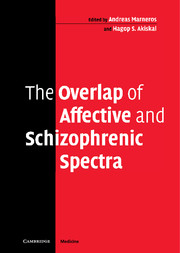Book contents
- Frontmatter
- Contents
- List of contributors
- Preface
- 1 The paradigma of overlapping affective and schizophrenic spectra: schizoaffective conditions
- 2 The overlapping of the spectra: overlapping genes and genetic models
- 3 The continuum of psychosis and its genetic basis
- 4 Functional psychoses: molecular-genetic evidence for a continuum
- 5 State- and trait-related deficits in sustained attention in bipolar disorder: are there any overlaps with schizophrenia?
- 6 The concept of schizoaffective disorder: utility versus validity and reliability – a transcultural perspective
- 7 Phenomenological approaches to the schizoaffective spectrum
- 8 Clinical course of schizoaffective disorders
- 9 Depressive syndromes in schizophrenia
- 10 The overlapping of the spectra: brief and acute psychoses
- 11 Overlapping of the spectra: physical comorbidity between schizophrenia and affective disorders
- 12 The overlapping of the spectra suicide
- 13 Biological treatment of schizoaffective disorders
- 14 Psychological therapies and schizoaffective disorders
- Epilogue: The interface of affective and schizophrenic disorders: a cross between two spectra?
- Index
13 - Biological treatment of schizoaffective disorders
Published online by Cambridge University Press: 02 September 2009
- Frontmatter
- Contents
- List of contributors
- Preface
- 1 The paradigma of overlapping affective and schizophrenic spectra: schizoaffective conditions
- 2 The overlapping of the spectra: overlapping genes and genetic models
- 3 The continuum of psychosis and its genetic basis
- 4 Functional psychoses: molecular-genetic evidence for a continuum
- 5 State- and trait-related deficits in sustained attention in bipolar disorder: are there any overlaps with schizophrenia?
- 6 The concept of schizoaffective disorder: utility versus validity and reliability – a transcultural perspective
- 7 Phenomenological approaches to the schizoaffective spectrum
- 8 Clinical course of schizoaffective disorders
- 9 Depressive syndromes in schizophrenia
- 10 The overlapping of the spectra: brief and acute psychoses
- 11 Overlapping of the spectra: physical comorbidity between schizophrenia and affective disorders
- 12 The overlapping of the spectra suicide
- 13 Biological treatment of schizoaffective disorders
- 14 Psychological therapies and schizoaffective disorders
- Epilogue: The interface of affective and schizophrenic disorders: a cross between two spectra?
- Index
Summary
Introduction
One example or model of the overlap of affective and schizophrenic spectra could be assumed to be the schizoaffective disorders (SAD). This topic is extensively dealt with in the first chapter of this book, so to avoid redundancy we refer to this chapter as well as to books extensively discussing the topic, such as Marneros and Tsuang 1986, 1990, Marneros, et al. 1995a, Marneros and Angst et al., 2000 as well as Marneros and Goodwin, 2005 a, b (see Chapter 1 references).
In contrast to schizophrenia and recurrent affective disorders, SAD is rarely the focus of treatment guidelines. The standard textbooks of psychopharmacology contain no chapters on the treatment of schizoaffective disorders (e.g., Schatzberg and Nemeroff, 2004). Therefore, this chapter aims at summarizing the results pertaining to acute and long-term treatment of SAD. After a brief methodological part, the results regarding acute treatment of SAD episodes will be reviewed followed by an overview of SAD long-term treatment. The chapter will end with a summary of preliminary treatment guidelines that can be inferred from the data reviewed.
Methods of review
This review is restricted to the efficacy and effectiveness of pharmacological treatments for schizoaffective disorders. Methodologically it is a non-systematic update of the most recent systematic review of SAD long-term treatment (Baethge, 2003a).
- Type
- Chapter
- Information
- The Overlap of Affective and Schizophrenic Spectra , pp. 248 - 263Publisher: Cambridge University PressPrint publication year: 2006

